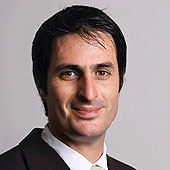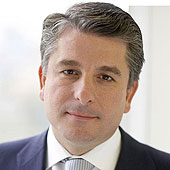 |
|
 |
Open Innovation Newsletter
Edition 26 - July 2013 |
|
|
|
 |
Open Innovation Newsletter is produced by Wenovate – Open Innovation Center. It brings interviews with professionals involved in the practice of OI in Brazil with the aim of registering cases, debating concepts and creating opportunities. It also brings articles and information about courses and events. |
|

ONE QUESTION, THREE ANSWERS
What are the key factors to lead for innovation?
 |
Stefan Reich
Director of CLA, Peru
“Innovation is the result of a combination of a certain context, its demands and the capacity of some individuals that perceive an opportunity and dares to experiment. In organizations, managers seek control and security, which are vial for the companies. The innovation leader challenges this balance and searches for something new. Sometimes, middle managers become obstacles for innovation, but that's because the system forces them to, even when they want to change. That's why leaders for innovation emerge precisely when trying to break the current paradigm. That is also true for social issues, such as when Nelson Mandela challenged the established logic in South Africa. Innovation leadership demands time, a lot of effort and tolerance.” |

 |
Juan Pedro Moreno Dias
Managing Director of Global Baking at Accenture, Spain
“I understand that it's the people who drive innovation forward. It's important to have money, the context is also important, but what makes the difference are the ones who act as agents of innovation – people who are actually interested in pushing the organization forward. An interesting concept is the “innovation angel”. It could be an employee of any sector that brings dynamics to the company and makes it move. For those people to work, management needs to be tolerant with failure, because that's how you create new things. But this kind of management only is not enough if the company doesn't have an innovation essence and very established and decentralized processes.” |

 |
Salvatore Iaconesi
President of Art is Open Source, Italy
“Innovation could be understood as an emerging process: a series of factors, practices and technologies that somehow are adopted by society. Leadership is connected with the way certain subjects recognize trends and perform them. Leadership for innovation is the ability of understanding the environment and to generate meaning with it. Leadership is a construct, built with communication and motivation. There are some genius minds that can create something completely new, but they're rare and inimitable. Steve Jobs' innovations are not a product of his genius mind, but of the fact that he was immersed in a very specific network composed of complementary competencies. In such ecosystem, Jobs was a hacker that captured important trends, used methodologies to extract meaning from them and acted to put them into practice.” |
[+] Top
|
|
 |
INTERVIEW
Changing to (un)innovate
 Augusto de Franco, especialista e criador da Escola de Redes. If your concept of social network is restricted to Facebook, Linkedin and Twitter, it's time to rethink it. Those are social media, platforms where networks dwell. We are – and always have been – parts of complex networks that exist regardless of technology. The difference is that, nowadays, the network seems to be more convoluted and interconnected. This affects organizations and the way they innovate.
To understand how, we talked to expert Augusto de Franco – creator of Escola de Redes (school of networks), with a myriad of books published about the subject and extensive work with big companies. For him, the company's structure with which we are used to (hierarchic, physic, systematic) is arbitrary: it ignores the spontaneous connections made between people and tries to redesign relationships. In the name of control and organization, they hold back the capacity for innovation. As he points out, several times, these companies put their efforts in not allowing innovation to happen.
Wenovate: In what way companies understand social networks?
Augusto: Companies don't know what a network is, they confuse social network with social media, they think the network is a platform, not an organization pattern. They think the network is something you create, not something that already exists. Every company is a network below the autocratic model that suffocates it. The management works as an obstruction of flux, that captures it and leaves it spinning inside. That management is based on command and control: it tries to regulate that flux.
Wenovate: What happens when they start questioning this model?
Augusto: Sometimes, when companies start to think about networks, they want to do what they always do: to change with no real change. When you find out there's distributed pattern, you need to change the configuration to a decentralized direction. The problem is that there are obstacles. And normally they are not in the high direction, but in the middle management. The middle management is worried about keeping the current dynamics, in being promoted, in not losing its current position. To change a plastered structure is to threaten those positions. There are political concerns that work as antigens to change, especially in the transition of a hierarchic company to a network company. The consultancy market works like that. A great majority of consultancy companies doesn't change anything because when do, it becomes dangerous. The managers feel threatened, IT doesn't like it, HR finds it difficult, the legal department bars it.
Wenovate: How does a network company work?
Augusto: A network company is the normal path, with not so many restrictions. It's not forbidden to use Facebook; employees are not obliged to use only Internet Explorer. What we see is an employee who can't access Youtube, Dropbox, Google Drive. It's all in the name of security, to not lose control of what one does in the virtual world. To become a network company, you can't lock people up and make them go to the office everyday. Of course there are positions where physical presence is necessary, but that doesn't apply to the whole company. Until today companies lock up our bodies, make people go there in the morning and only leave at night. And when they're there, they stay in very small working stations, holding back mobility. There are no free spaces to co-create ideas because all spaces are regulated.
Besides, only the development department creates. It is wrong. The innovation environment has to involve the whole company. Innovation is the capacity of adaptation, which involves indicators. A sales increase of new products doesn't indicate the presence of innovation. Innovation is not to profit more, but to live more, to be more sustainable. The problem is that the companies were made to reproduce and now they need to create.
Wenovate: So the concept of open innovation is related to the concept of network.
Augusto: The network is actually the ecosystem: stakeholders, internal and external. The thing about open innovation is that it's only open if it's also distributed. It can't have solid walls to segregate it – it needs to have membranes.
Wenovate: What is the main challenge that companies face to innovate in that sense?
Augusto: Even if they're growing, companies can die, because they're exposed by to the so-called systemic risk. The average lifespan of a company is decreasing. Today, it's of 15 years, but it once was of 75. That's because of interactivity. The number of ways of doing things has multiplied and people have a lot of alternatives. That's why you can't only count on revenue. When a company grows, productivity tends to decrease and so does interactivity. That's a systemic risk. Take the example of Kodak, which became obsolete and then bam! It became inadequate.
Wenovate: It's a resistance to the disruptive innovation.
Augusto: The question is that the company tries to protect itself from changes, when it should be adapting to them. Mobile phone operators, for instance, are unnecessary. There is enough technology out there to substitute them for a much cheaper system. But, since they know that, they try to ally themselves with the government to prevent some changes, to create rules and bar innovation. They change, but to not innovate. This path has no chance of success.
Look at those agitations in the world in the first half of 2013. Companies think this has nothing to do with them, but with governments. They keep looking for a cause when there is no cause. This is society's metabolism. In the network, any stimulus, even if originated in the periphery of the system, is capable of provoking great change. In 2008, the systemic risk has taken a week to completely install the financial market crisis with Lehman Brothers.
Wenovate: Is there any way to prepare for those changes?
Augusto: There is no way to avoid the crisis, but whoever is more prepared to quickly change will make it through.
Wenovate: Are there any examples of companies organized in this way?
Augusto: There is not a pattern or a model when it comes to networks. Each network is different since each cluster of relationships is different. All companies are networks to a certain degree, but they don't recognize this. The network is a dynamic of organization. There have been many attempts to change. Some companies have been operating this way for a long time. I know one software development company that doesn't use email, only Facebook.
Wenovate: And does it work?
Augusto: It does. They use a closed group and everyone chats there. Some companies have their own platform, but that doesn't work. It's the same reason why most platforms for innovation don't work. People don't access those platforms because they're not part of their environment. Nobody leaves one place where they're interacting just to go interact somewhere else. A company with a network mentality knows that connections already exist and it's foolish to force them to change places. If everyone is on Facebook, why not interact there? When a platform needs injections from managers to force people to interact, it means that the network doesn't exist yet.
Wenovate: Could a sturdily structured company migrate to the network model of organization?
Augusto: It needs to make a transition to reconfigure everything, starting with its physical environment. You can't install a Windows software in a Apple machine.
Wenovate: How does innovation happen in that context?
Augusto: Innovation is disposition. In principle, innovation management is hard business. It's the collective intelligence that creates. Ten Einsteins don't create the theory of relativity. He was connected to other people and this network allowed him to draw those conclusions. That's why innovation is not a good idea, it's many ideas together that generate a creative group when combined. Innovation doesn't come out of an individual's brain, but from an innovative environment, from interaction. It's the consequence of collective intelligence with a certain arrangement. That's why it makes so much sense when companies organize themselves in clusters and they all grow together.
[+] Top
|

SUITE
Five years in Innovation Reference Center: the evolution of open innovation practices
Anderson Rossi - Dom Cabral Foundation
My five years experience in the coordination of the Innovation Reference Center at Dom Cabral Foundation (CRI) was very enriching and revealing for many reasons. First, because of the opportunity to improve the participating companies' practices for innovation. As the literature shows, innovation is the result of collective work, and interaction at the Center has allowed the companies managers to advance the debate about the best innovation practices. The generation of knowledge that came with the teamwork is also significant.
For some time over the last few years, open innovation became a crucial discussion topic. In that context, it's interesting to notice that, in 2009, when our first research about innovation practices has been carried out, almost 80% of the companies declared to have no experience or formal practice in the subject. The research results were also presented in the Open Innovation Seminar promoted by Wenovate and has drawn attention of everyone involved - most of all, of professor Henry Chesbrough, who was in the audience. In a debate about that data, alternative ways for the adoption of open innovation practices in Brazilian companies were pointed out. At that time, there were more doubts and uncertainty about the subject then properly examples to be presented.
Last May, when a new research about the group's practices was made, new results surprised us all. Research has shown that open innovation is already a reality in more than half of the companies participating in CRI and that tends to increase. It's also worth mentioning that some companies were very mature regarding their relationships with other actors involved in innovation – universities, clients and research teams. Another interesting data is that most of the companies that adopt innovation practices prioritize the phases of Research and Development – as opposed to the ideation phase.
We can conclude that open innovation as defined by professor Chesbrough is already a reality in many Brazilian companies. The two-way street adopted in open innovation management – that is, the flux of information, knowledge and technology from inside the company to the market, and vice-versa – is a recurring practice of many players.
[+] Top
|
|

FUNDING
Brazilian Ministry of Science, Technology and Innovation contradicts legislation for innovation
Rafael Levy, Allagii
A few weeks ago, the Brazilian Ministry of Science, Technology and Innovation (MCTI) promoted on the 25th of June in Brasilia the event “Contributions of tax incentives of Lei do Bem (Good Law) for increasing competitiveness through R,D &I”. It could be a regular presentation, with little news related to interpretation and application of the Law. However, what the Department of Technological Development and Innovation brought was unexpected. When defining its scope, the presentation, called “Conceptual Alignement of Good Law”, pointed as “non-contemplated” activities precisely what the Good Law defines as innovation itself.
The interpretation of MCTI separates "research and development" from "engineering activities" and understands that only the first is contemplated. Word by word, however, the Ministry's text repeats the Law's definition of innovation: “conception of new product or process of manufacturing, aggregation of new functionalities or characteristics to products or processes that generate improvements and effective quality gain and productivity, resulting in more competitiveness and market” .
To understand what this contradiction means, it is important to look at Brazilian legislation history. Created in 2005, the Law 11.196, or the Good Law, in its third chapter ("Fiscal Subsidies to Technological Innovation") states that it's meant to encourage activities of "technological research and technological development". The terms represent a change from the previous Law (PDTI/PDTA), which only referred to "research and technological development".
Despite that, in 2006, the executive power had joined the game with the publication of Decree-law 5.798, defining technological research and development of technological innovation as: "basic research, applied and experimental development". It was the first measure to limit interpretation and the most recent presentation strengthens it.
The newest presentation was one more restrictive movement. MCTI members seem to consider innovation only as pre-competitive technological development – that is, the basic and applied research phase, or the development of technologies executed before its actual employment in a product or process.
The problem of such guidance is that the definition in the Good Law – specially represented by the change in the definition of terms – makes it very clear that subsidies are for "development of technological innovation". Therefore, it includes the development of innovative products and processes and not only the technological development in the phase before product or process development.
During the last years, the subjects involved with innovation in Brazil are increasingly convinced about the need to favor more resources to innovation, given its strategic role to long-term economic maintenance. Innovation is the introduction of new products, services and processes that make sure the country stays competitive. Society only benefits from ideas, inventions and scientific and technological advances when they start being produced in a large scale and penetrate the market on a daily basis. It is when the transition between knowledge and market happens.
It is precisely to strengthen this connection that specific mechanisms to fund innovation were created, to distribute resources equally and to complement those already destined to scientific research. The interpretation of MCTI members, however, seems to contradict this by only praising the companies' creation - contrarily to what innovation actually is: the development and viability of market introduction.
Changes in interpretation could compromise the Law efficacy and open space for questions about MCTI position. A example is the last Annual Report of Fiscal Subsidies Update, a document published by MCTI about the investments on innovation in 2011. It makes clear that there is a 20% decrease in the volume of resources destined to research and development made through the Good Law – from R$ 1,72 billion in the previous year to R$ 1,4 billion. Yet, when it analyzes the situation, evading its own responsibility, the Ministry blames the global economic crisis and “the low business confidence due to the accumulation of uncertainties” for this reduction, ignoring the restrictive policies as demotivation factors.
The gap between law enforcement and the reality of Brazilian companies is still very large. Evidence of this is the 2008 data from the Survey of Technological Innovation of the Brazilian Institute of Geography and Statistics (IBGE), which shows that about 30,000 companies in Brazil invest in R&D to generate innovation. However, MCTI accessions to benefits of the Good Law fail to a thousand per year.
The document presented in the 25th of June brings another statement that enforces the feeling of mismatch in MCTI actions. The document states that the objective of the legislation is to stimulate companies to develop “internally” activities of technological research and development of technological innovation.
This emphasis is contradicted by the text of the legislation, which explicitly encourages outside activities of R & D, including providing greater benefits to cooperation with ICTs. The Article 17 of Good Law highlights the possibility of usinf the law to expenditures "on technological research and development of technological innovation in the country contracted with university, research institution or independent inventor". In the same text, the Article 19A states about "design scientific and technological research and technological innovation to be implemented by Institute of Science and Technology (ICT) [...] or by nonprofit private scientific and technological entities".
All these arguments lead to the conclusion that there is a misalignment conceptual in the behavior of MCTI members, which insists on reinforcing obsolete paradigms of innovation management. The legislation is wide open to interpretation and discussion, but the trend of the ministry to impose rules for the way in which companies must innovate ignores the breadth and complexity of the innovation process, which occurs in different ways, more closed or more open, and is only successful when it completes the route to market. In an attempt to control and direct the innovation practices, MCTI ends in contradicting the laws, while it should be boosting the advancement of the law, promoting the most of its chances.
[+] Topo
|
|

ARTICLE
There is no innovation without leadership
Bruno Rondani
There are many ways to define innovation. All of them, though, are connected to change – especially the result of actions that came from this change. Companies are structured to remain constant, to have well-defined processes and to keep the so-called performance machine in full steam: efficient, reliable and standardized. But, to survive over time, companies need to change.
Does it seem contradictory? Yes, the relationship between productivity and innovation is built upon a permanent tension. Different forces push the company both to the optimization of established processes and to the review of its activities. In this tug-of-war, the performance machine's resistance tends to be higher. For change to happen, it is crucial to have leaders capable of mobilizing innovation.
It was precisely because of such paradox that companies created the position of the innovation manager. The mission of this professional is to guarantee that new fluxes of ideas and change ideas survive until they are actually implemented. They need to sustain a process despite the immediate loss it causes to other managers while it imposes uncertain future gains. Strong leadership is expected in that process.
However, it is foolish to believe that leadership for innovation is restricted to positions. In an increasingly interconnected world, leaders capable of managing innovation could emerge anywhere: in the lower level of employees, in sectors not directly connected to R&D and even outside of the company. Those leaders could be in startups, in the client community and in consultancy with any other instance with which the organization is related.
Corporations exist in the middle of a context of rapid and radical changes in which decision-making is not a simple process. To lead innovation in this environment is therefore not a technical problem, but an adaptive challenge. The technical problem is when it is presumed that there is a pre-conceived action repertory. The adaptive challenge is when it's understood that answers need to be constructed.
The other studies about leadership show that this contraposition of scenarios is intimately connected to the difference between leadership and authority. When it's understood that innovation is connected to authority, the expected attitude is of someone who tackles problems aiming to eliminate chaos and tensions and to provide practical and objective answers. The goal is to alter as less as possible, using technical solutions with the minimum impact for the emerging problems.
On the other hand, the leader, viewed as a team member – and not someone who is above it –, sees challenges as work material. They orchestrate and share the difficulties with the partners and, in their search for answers, guide the proposal and the questions. They understand that challenges are hard to identify. Therefore their solutions need to be built and could demand profound changes. That's why the leader, in the context of innovation, has a very strong entrepreneurship character, and it doesn't matter if he or she is the owner of the company or not.
[+] Top
|
|

WENOVATE & PARTNERS NEWS
Wenovate promotes course of strategic leadership
Wenovate, in partnership with the Centro de Liderazgo Strategic, will promote from 24-26 of September the course "Strategic Leadership". Directed to entrepreneurs and executives from the private and public sector, the course will tackle the strategic aspect of leadership based on the conceptual model from Harvard University. More info at: +55 11 3500-5090.
FDC's Strategic Innovation Management Program open
Dom Cabral foundation will conduct from 16-20 of September the Strategic Innovation Management Program. The program offers training for companies to learn how to integrate the key aspects, like strategy, culture and method, in order to incorporate innovation. Registering can be made at the organization's website. Wenovate associates can benefit from a 10% discount: www.fdc.org.br.
Senai-Sesi Call for Innovation offers R$ 30,5 milion for innovative projects
The selective process for Senai-Sesi Call for Innovation 2013 is open. The Call reserves R$ 30,5 milion and aims to promote the technology innovation in health, security, education and culture trhough products, process and services in companies of different sizes. Information: www.editaldeinovacao.com.br.
Itajuba promotes open innovation event
From 4-6 of November, the Federal University of Itajuba (Minas Gerais, Brazil) promotes the 1st Itajuba Open Innovation Fair. The event is open but the registers must be done previously. Informations: www.b2mlportal.com.br/inovacao/.
[+] Top
|
|

|

SAVE THE DATE

25 - 27 November - WTC São Paulo |
[+] Top
|
|

 |
| |
Follow the activities of Wenovate and link up with other innovation professionals. |
|
|
|
| Sponsorship and collaboration |
 |
|











